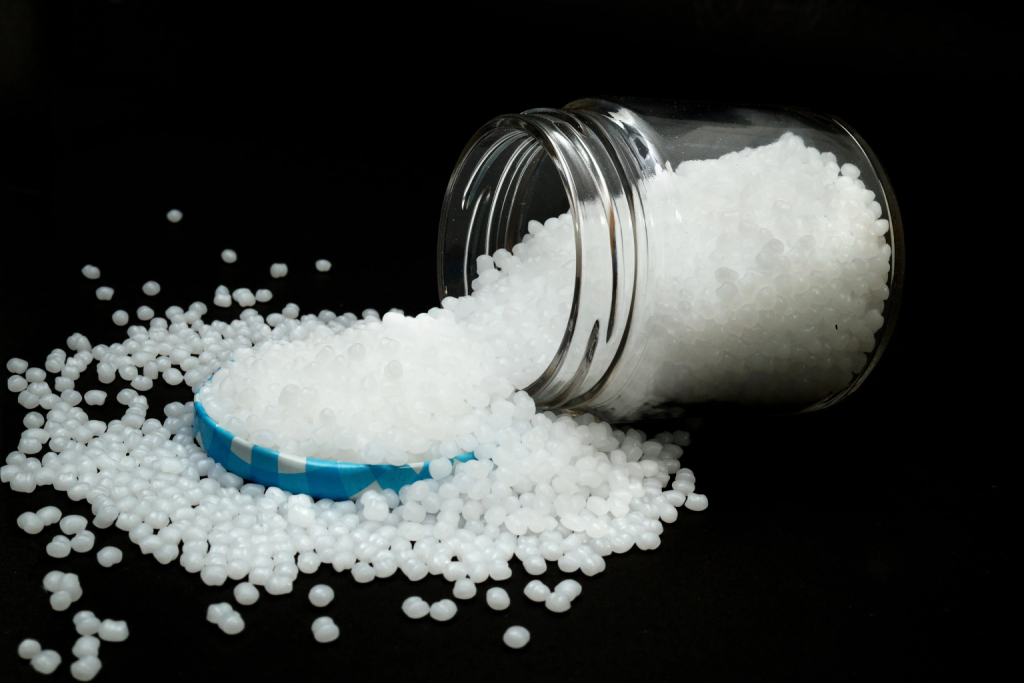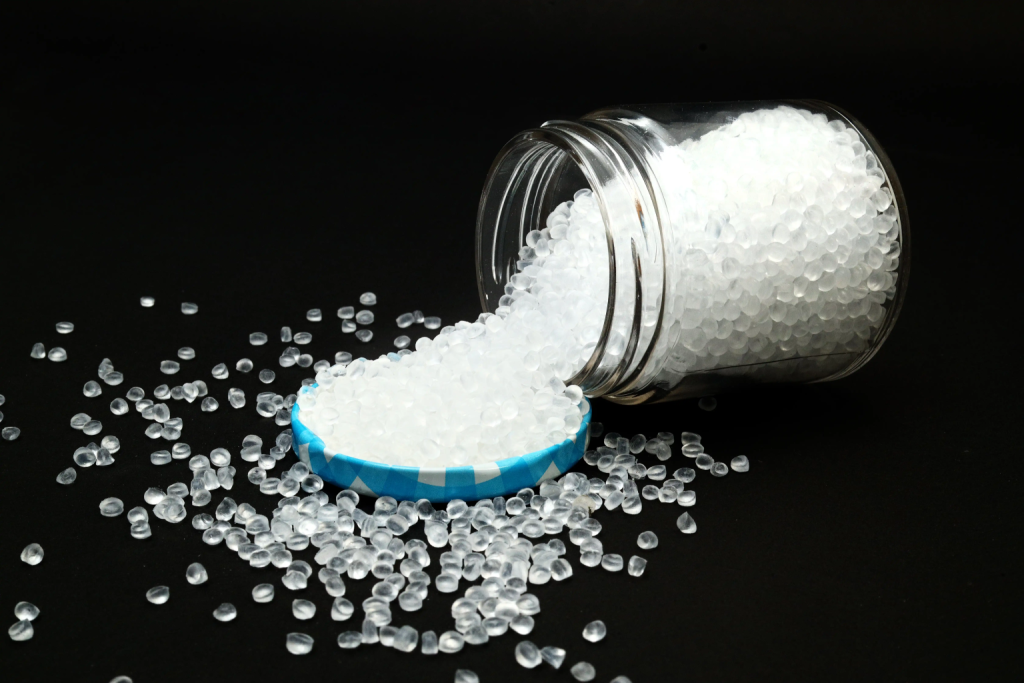HIGH-DENSITY POLYETHYLENE (HDPE)

High-density polyethylene (HDPE) is a popular thermoplastic polymer recognized for its strength, durability, and versatility. Made from petroleum, HDPE is formed through polymerization, a process in which ethylene molecules are bonded together to create long, dense chains. This structure gives HDPE a high strength-to-density ratio, making it both strong and lightweight. Its resilience, combined with other beneficial properties, makes HDPE suitable for a wide range of industrial and everyday applications.
One of HDPE’s standout features is its excellent resistance to moisture, chemicals, and UV radiation, making it an ideal material for outdoor applications. HDPE is commonly used in the production of pipes, where its durability and resistance to corrosion allow it to withstand various environmental conditions,
ensuring long-term performance. Additionally, HDPE is widely used in packaging materials, from plastic bottles and containers to durable shipping materials, thanks to its toughness and resistance to impact. The polymer is also a go-to choice for playground equipment, as it withstands frequent use, weather exposure, and physical stress.
In the home, HDPE finds application in numerous household items due to its safety and strength. It is used in toys, storage containers, cutting boards, and kitchen utensils, providing a durable and reliable option for items that may see frequent handling and wear.
An important environmental benefit of HDPE is its high recyclability. It is one of the most widely recycled plastics, commonly processed into new products, including plastic lumber, which is often used for outdoor furniture and decking. The ability to recycle HDPE into new products reduces waste and makes it an eco-friendly material in the context of circular economy practices.
In summary, HDPE is a strong, durable, and highly recyclable thermoplastic polymer. Its resistance to environmental stresses and wide applicability make it a key material for a range of industries, from packaging and piping to household goods and outdoor equipment.
One of HDPE’s standout features is its excellent resistance to moisture, chemicals, and UV radiation, making it an ideal material for outdoor applications. HDPE is commonly used in the production of pipes, where its durability and resistance to corrosion allow it to withstand various environmental conditions, ensuring long-term performance. Additionally, HDPE is widely used in packaging materials, from plastic bottles and containers to durable shipping materials, thanks to its toughness and resistance to impact. The polymer is also a go-to choice for playground equipment, as it withstands frequent use, weather exposure, and physical stress.
In the home, HDPE finds application in numerous household items due to its safety and strength. It is used in toys, storage containers, cutting boards, and kitchen utensils, providing a durable and reliable option for items that may see frequent handling and wear.
An important environmental benefit of HDPE is its high recyclability. It is one of the most widely recycled plastics, commonly processed into new products, including plastic lumber, which is often used for outdoor furniture and decking. The ability to recycle HDPE into new products reduces waste and makes it an eco-friendly material in the context of circular economy practices.
In summary, HDPE is a strong, durable, and highly recyclable thermoplastic polymer. Its resistance to environmental stresses and wide applicability make it a key material for a range of industries, from packaging and piping to household goods and outdoor equipment.

High-density polyethylene (HDPE) is a popular thermoplastic polymer recognized for its strength, durability, and versatility. Made from petroleum, HDPE is formed through polymerization, a process in which ethylene molecules are bonded together to create long, dense chains. This structure gives HDPE a high strength-to-density ratio, making it both strong and lightweight. Its resilience, combined with other beneficial properties, makes HDPE suitable for a wide range of industrial and everyday applications.
One of HDPE’s standout features is its excellent resistance to moisture, chemicals, and UV radiation, making it an ideal material for outdoor applications. HDPE is commonly used in the production of pipes, where its durability and resistance to corrosion allow it to withstand various environmental conditions, ensuring long-term performance. Additionally, HDPE is widely used in packaging materials, from plastic bottles and containers to durable shipping materials, thanks to its toughness and resistance to impact. The polymer is also a go-to choice for playground equipment, as it withstands frequent use, weather exposure, and physical stress.
In the home, HDPE finds application in numerous household items due to its safety and strength. It is used in toys, storage containers, cutting boards, and kitchen utensils, providing a durable and reliable option for items that may see frequent handling and wear.
An important environmental benefit of HDPE is its high recyclability. It is one of the most widely recycled plastics, commonly processed into new products, including plastic lumber, which is often used for outdoor furniture and decking. The ability to recycle HDPE into new products reduces waste and makes it an eco-friendly material in the context of circular economy practices.
In summary, HDPE is a strong, durable, and highly recyclable thermoplastic polymer. Its resistance to environmental stresses and wide applicability make it a key material for a range of industries, from packaging and piping to household goods and outdoor equipment.
One of HDPE’s standout features is its excellent resistance to moisture, chemicals, and UV radiation, making it an ideal material for outdoor applications. HDPE is commonly used in the production of pipes, where its durability and resistance to corrosion allow it to withstand various environmental conditions, ensuring long-term performance. Additionally, HDPE is widely used in packaging materials, from plastic bottles and containers to durable shipping materials, thanks to its toughness and resistance to impact. The polymer is also a go-to choice for playground equipment, as it withstands frequent use, weather exposure, and physical stress.
In the home, HDPE finds application in numerous household items due to its safety and strength. It is used in toys, storage containers, cutting boards, and kitchen utensils, providing a durable and reliable option for items that may see frequent handling and wear.
An important environmental benefit of HDPE is its high recyclability. It is one of the most widely recycled plastics, commonly processed into new products, including plastic lumber, which is often used for outdoor furniture and decking. The ability to recycle HDPE into new products reduces waste and makes it an eco-friendly material in the context of circular economy practices.
In summary, HDPE is a strong, durable, and highly recyclable thermoplastic polymer. Its resistance to environmental stresses and wide applicability make it a key material for a range of industries, from packaging and piping to household goods and outdoor equipment.
Benefits of High-Density Polyethylene (HDPE)

Durablity

Lightweight

Electrical Insulation
One stop solution for polymers
Supplying high-quality polymers to fuel your business success!
Get in touch with us today to discover more about our premium polymer supplies!











